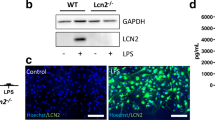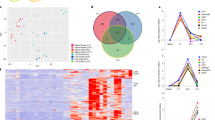Abstract
Astroglia is well-known to be integrated in the complex regulation of neuroinflammation in the central nervous system. Astrocytes become activated and synthesize cytokines, chemokines, and prostanoids during degenerative and vulnerable processes and interact with other immune-competent cells. Degenerative disorders often occur in a brain-region-specific fashion suggesting differences in the activity and reactivity of innate immune cells. We have investigated the potency of lipopolysaccharides (LPS) to differently stimulate astrocytes from the cortex and midbrain. Astroglial cultures were prepared from Bagg albino/c mice and exposed to LPS. Astrocytes from both brain areas already differed in their capacity and profile of cytokine expression under basal unstimulated conditions. In response to LPS, we observed both a region-specific pattern of up-regulation of distinct cytokines and differences in the extent and time-course of activation. Our data demonstrate that astrocytes reveal a region-specific basal profile of cytokine expression and a selective area-specific regulation of cytokines upon LPS-induced inflammation. This makes astrocytes likely candidates to be responsible for region-specific incidence rates of neurological and neurodegenerative disorders.





Similar content being viewed by others
Abbreviations
- AD:
-
Alzheimer’s disease
- ALS:
-
amyotrophic lateral sclerosis
- as:
-
antisense
- bFGF:
-
basic fibroblast growth factor
- CD-40:
-
cluster of designation-40
- CNS:
-
central nervous system
- DNA:
-
deoxyribonucleic acid
- EDTA:
-
ethylenediaminetetraacetic acid
- GFAP:
-
glial cell line-derived neurotrophic factor
- HPRT:
-
hypoxanthin-guanin-phosphoribosyl-transferase
- IFN:
-
interferon
- IL:
-
interleukin
- LPS:
-
lipopolysaccharides
- MCP-1:
-
monocyte chemo-attractant protein-1
- M-CSF:
-
macrophage colony stimulating factor
- MD-2:
-
myeloid differentiation protein-2
- MIP-3α:
-
macrophage inflammatory protein-3α
- MS:
-
multiple sclerosis
- Myd88:
-
myeloid differentiation factor-88
- OD:
-
optical density
- PD:
-
Parkinson’s disease
- PCR:
-
polymerase chain reaction
- PGE2 :
-
prostaglandin E2
- POS:
-
positive control
- Neg:
-
negative control
- RANTES:
-
regulated on activation, normal T-cell expressed and presumably secreted
- RNA:
-
ribonucleic acid
- RT:
-
reverse transcription
- SDS:
-
sodiumdodecyl sulfate
- s:
-
sense
- TLR:
-
Toll-like receptor
- TNFα:
-
tumor necrosis factor α
- VEGF:
-
vascular epithelial growth factor
References
Allan, S. M., & Rothwell, N. J. (2001). Cytokines and acute neurodegeneration. Nature Reviews Neuroscience, 2, 734–744.
Aloisi, F., Ria, F., & Adorini, L. (2000). Regulation of T-cell responses by CNS antigen-presenting cells: different roles for microglia and astrocytes. Immunology Today, 21, 141–147.
Bernaudin, M., Nouvelot, A., MacKenzie, E. T., & Petit, E. (1998). Selective neuronal vulnerability and specific glial reactions in hippocampal and neocortical organotypic cultures submitted to ischemia. Experimental Neurology, 150, 30–39.
Calabresi, P., Centonze, D., & Bernardi, G. (2000). Cellular factors controlling neuronal vulnerability in the brain: a lesson from the striatum. Neurology, 55, 1249–1255.
Carson, M. J., Doose, J. M., Melchior, B., Schmid, C. D., & Ploix, C. C. (2006). CNS immune privilege: hiding in plain sight. Immunology Review, 213, 48–65.
Chan, W. Y., Kohsaka, S., & Rezaie, P. (2007). The origin and cell lineage of microglia: new concepts. Brain Research Review, 53, 344–354.
Chung, I. Y., & Benveniste, E. N. (1990). Tumor necrosis factor-alpha production by astrocytes. Induction by lipopolysaccharide, IFN-gamma, and IL-1 beta. Journal of Immunology, 144, 2999–3007.
Darlington, C. L. (2005). Astrocytes as targets for neuroprotective drugs. Current Opinion in Investigational Drugs, 6, 700–703.
Das, S., & Potter, H. (1995). Expression of the Alzheimer amyloid-promoting factor antichymotrypsin is induced in human astrocytes by IL-1. Neuron, 14, 447–456.
Dong, Y., & Benveniste, E. N. (2001). Immune function of astrocytes. Glia, 36, 180–190.
Farina, C., Aloisi, F., & Meinl, E. (2007). Astrocytes are active players in cerebral innate immunity. Trends in Immunology, 28, 138–145.
Farina, C., Krumbholz, M., Giese, T., Hartmann, G., Aloisi, F., & Meinl, E. (2005). Preferential expression and function of Toll-like receptor 3 in human astrocytes. Journal of Neuroimmunology, 159, 12–19.
Fisher, L., Samuelsson, M., Jiang, Y., Ramberg, V., Figueroa, R., Hallberg, E., et al. (2007). Targeting cytokine expression in glial cells by cellular delivery of an NF-kappaB decoy. Journal of Molecular Neuroscience, 31, 209–219.
Franzen, R., Bouhy, D., & Schoenen, J. (2004). Nervous system injury: focus on the inflammatory cytokine ‘granulocyte-macrophage colony stimulating factor’. Neuroscience Letters, 361, 76–78.
Gosselin, D., & Rivest, S. (2007). Role of IL-1 and TNF in the brain: twenty years of progress on a Dr. Jekyll/Mr. Hyde duality of the innate immune system. Brain Behavior and Immunity, 21, 281–289.
Hald, A., & Lotharius, J. (2005). Oxidative stress and inflammation in Parkinson’s disease: is there a causal link? Experimental Neurology, 193, 279–290.
Han, B. C., Koh, S. B., Lee, E. Y., & Seong, Y. H. (2004). Regional difference of glutamate-induced swelling in cultured rat brain astrocytes. Life Sciences, 76, 573–583.
Huh, G. Y., Roh, M. S., & Bae, H. R. (2001). Age-related regional difference of interleukin-1 expression in rat brain after lipopolysaccharide treatment. Journal of Korean Medical Science, 16, 103–107.
Jack, C. S., Arbour, N., Manusow, J., Montgrain, V., Blain, M., McCrea, E., et al. (2005). TLR signaling tailors innate immune responses in human microglia and astrocytes. Journal of Immunology, 175, 4320–4330.
Johann, S., Kampmann, E., Denecke, B., Arnold, S., Kipp, M., Mey, J., et al. (2008). Expression of enzymes involved in the prostanoid metabolism by cortical astrocytes after LPS-induced inflammation. Journal of Molecular Neuroscience, 34, 177–185.
Karakaya, S., Kipp, M., & Beyer, C. (2007). Oestrogen regulates the expression and function of dopamine transporters in astrocytes of the nigrostriatal system. Journal of Neuroendocrinology, 19, 682–690.
Kim, W. G., Mohney, R. P., Wilson, B., Jeohn, G. H., Liu, B., & Hong, J. S. (2000). Regional difference in susceptibility to lipopolysaccharide-induced neurotoxicity in the rat brain: role of microglia. Journal of Neuroscience, 20, 6309–6316.
Kim, Y. S., & Joh, T. H. (2006). Microglia, major player in the brain inflammation: their roles in the pathogenesis of Parkinson's disease. Experimental and Molecular Medicine, 38, 333–347.
Kipp, M., Karakaya, S., Pawlak, J., Araujo-Wright, G., Arnold, S., & Beyer, C. (2006). Estrogen and the development and protection of nigrostriatal dopaminergic neurons: concerted action of a multitude of signals, protective molecules, and growth factors. Frontiers in Neuroendocrinology, 27, 376–390.
Kipp, M., Karakaya, S., Johann, S., Kampmann, E., Mey, J., & Beyer, C. (2007). Oestrogen and progesterone reduce lipopolysaccharide-induced expression of tumour necrosis factor-alpha and interleukin-18 in midbrain astrocytes. Journal of Neuroendocrinology, 19, 819–822.
Kostrzewa, R. M., & Segura-Aguilar, J. (2003). Novel mechanisms and approaches in the study of neurodegeneration and neuroprotection. A review. Neurotoxicity Research, 5, 375–383.
Krasowska-Zoladek, A., Banaszewska, M., Kraszpulski, M., & Konat, G. W. (2007). Kinetics of inflammatory response of astrocytes induced by TLR 3 and TLR4 ligation. Journal of Neuroscience Research, 85, 205–212.
Lucas, S. M., Rothwell, N. J., & Gibson, R. M. (2006). The role of inflammation in CNS injury and disease. Britich Journal of Pharmacology, 147(Suppl 1), S232–S240.
Malipiero, U. V., Frei, K., & Fontana, A. (1990). Production of hemopoietic colony-stimulating factors by astrocytes. Journal of Immunology, 144, 3816–3821.
Maragakis, N. J., & Rothstein, J. D. (2006). Mechanisms of disease: astrocytes in neurodegenerative disease. Natural Clinical Practice Neurology, 2, 679–689.
McGeer, P. L., & McGeer, E. G. (2008). Glial reactions in Parkinson’s disease. CNS Drugs, 21, 789–797.
McGuire, S. O., Ling, Z. D., Lipton, J. W., Sortwell, C. E., Collier, T. J., & Carvey, P. M. (2001). Tumor necrosis factor alpha is toxic to embryonic mesencephalic dopamine neurons. Experimental Neurology, 169, 219–230.
Mennicken, F., Maki, R., de Souza, E. B., & Quirion, R. (1999). Chemokines and chemokine receptors in the CNS: a possible role in neuroinflammation and patterning. Trends in Pharmacological Science, 20, 73–78.
Moisse, K., & Strong, M. J. (2006). Innate immunity in amyotrophic lateral sclerosis. Biochimica et Biophysica Acta, 1762, 1083–1093.
Mosley, R. L., Benner, E. J., Kadiu, I., Thomas, M., Boska, M. D., Hasan, K., et al. (2006). Neuroinflammation, oxidative stress and the pathogenesis of Parkinson’s disease. Clinical Neuroscience Research, 6, 261–281.
Nagatsu, T., & Sawada, M. (2005). Inflammatory process in Parkinson’s disease: role for cytokines. Current Pharmaceutical Design, 11, 999–1016.
Nguyen, M. D., Julien, J. P., & Rivest, S. (2002). Innate immunity: the missing link in neuroprotection and neurodegeneration? Nature Reviews Neuroscience, 3, 216–227.
Palsson-McDermott, E. M., & O'Neill, L. A. (2004). Signal transduction by the lipopolysaccharide receptor, Toll-like receptor-4. Immunology, 113, 153–162.
Pawlak, J., & Beyer, C. (2005). Developmental expression of MNAR mRNA in the mouse brain. Cell and Tissue Research, 320, 545–549.
Pawlak, J., Karolczak, M., Krust, A., Chambon, P., & Beyer, C. (2005). Estrogen receptor-alpha is associated with the plasma membrane of astrocytes and coupled to the MAP/Src-kinase pathway. Glia, 50, 270–275.
Pistritto, G., Franzese, O., Pozzoli, G., Mancuso, C., Tringali, G., Preziosi, P., et al. (1999). Bacterial lipopolysaccharide increases prostaglandin production by rat astrocytes via inducible cyclooxygenase: evidence for the involvement of nuclear factor kappaB. Biochemical and Biophysical Research Communications, 263, 570–574.
Qin, L., Wu, X., Block, M. L., Liu, Y., Breese, G. R., Hong, J. S., et al. (2007). Systemic LPS causes chronic neuroinflammation and progressive neurodegeneration. Glia, 55, 453–462.
Schneider, A., Kuhn, H. G., & Schabitz, W. R. (2005). A role for G-CSF (granulocyte-colony stimulating factor) in the central nervous system. Cell Cycle, 4, 1753–1757.
Skaper, S. D. (2007). The brain as a target for inflammatory processes and neuroprotective strategies. Annals of the New York Academy of Sciences, 1122, 23–34.
Suzumura, A., Takeuchi, H., Zhang, G., Kuno, R., & Mizuno, T. (2006). Roles of glia-derived cytokines on neuronal degeneration and regeneration. Annals of the New York Academy of Sciences, 1088, 219–229.
Takuma, K., Baba, A., & Matsuda, T. (2004). Astrocyte apoptosis: implications for neuroprotection. Progress Neurobiology, 72, 111–127.
Teismann, P., & Schulz, J. B. (2004). Cellular pathology of Parkinson's disease: astrocytes, microglia and inflammation. Cell and Tissue Research, 318, 149–161.
Tzeng, S. F., Hsiao, H. Y., & Mak, O. T. (2005). Prostaglandins and cyclooxygenases in glial cells during brain inflammation. Current Drug Targets Inflammation Allergy, 4, 335–340.
van Noort, J. M. (2006). Human glial cell culture models of inflammation in the central nervous system. Drug Discovery Today, 11, 74–80.
Vesce, S., Rossi, D., Brambilla, L., & Volterra, A. (2007). Glutamate release from astrocytes in physiological conditions and in neurodegenerative disorders characterized by neuroinflammation. International Review of Neurobiology, 82, 57–71.
Wang, X. (2005). Investigational anti-inflammatory agents for the treatment of ischemic brain injury. Expert Opinion on Investigational Drugs, 14, 393–409.
Williams, A., Piaton, G., & Lubetzki, C. (2007). Astrocytes—friends or foes in multiple sclerosis? Glia, 55, 1300–1312.
Acknowledgment
This work was supported by a START grant from the Medical Faculty of the RWTH Aachen (M.K.). We would like to thank U. Zahn and H. Helten for their excellent technical support.
Author information
Authors and Affiliations
Corresponding author
Rights and permissions
About this article
Cite this article
Kipp, M., Norkute, A., Johann, S. et al. Brain-Region-Specific Astroglial Responses In Vitro After LPS Exposure. J Mol Neurosci 35, 235–243 (2008). https://doi.org/10.1007/s12031-008-9057-7
Received:
Accepted:
Published:
Issue Date:
DOI: https://doi.org/10.1007/s12031-008-9057-7




